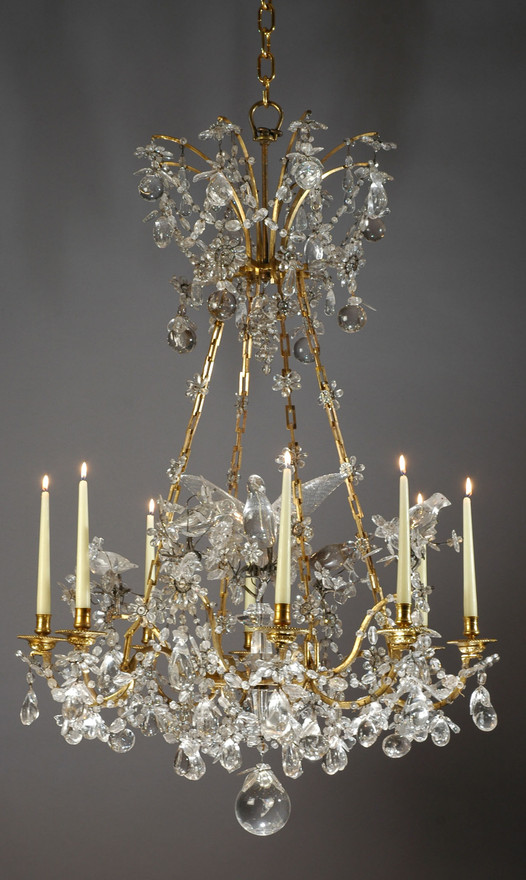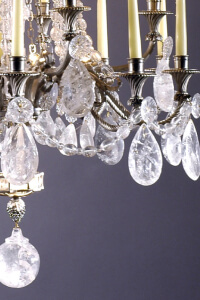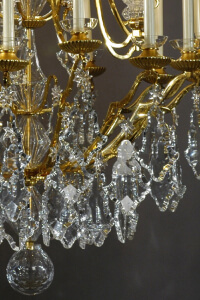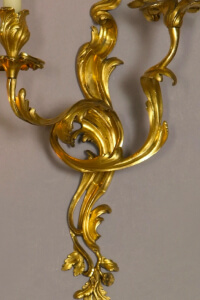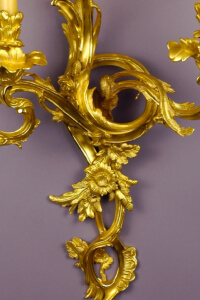In the 18th century, a significant transformation took place in chandelier craftsmanship. Instead of making use of traditional materials such as wood and brass, artisans turned to more prestigious materials including rock crystal, at the time considered the most precious of all. This mineral is still talked about today, particularly through the Voyage dans le Cristal exhibition at the Cluny museum. This bird Chandelier was, for its part, produced by the Mathieu Lustrerie workshops and based off of a chandelier model at the heart of the Etienne Vouland Museum chandelier collection. The wealth of the chandelier's owner is clearly manifested by the abundance of crystal decorations, including tassels, skittles, beads and carved birds. Until the 18th century, these decorations were regulated by sumptuary laws, which aimed to maintain social order by limiting excessive spending on ornaments and luxuries.
The choice of rock crystal is not only aesthetic but also reflects an important social standing. Owning a rock crystal chandelier was a symbol of high status within society. Originally, these rock crystal chandeliers were reserved for royal and wealthy clients, which reinforced their social prestige. However, to make these chandeliers more accessible, industrial crystals emerged in the 18th century, providing a more affordable alternative.
In the 18th century, the chandelier definitively abandoned wood and brass for a design in more precious metal such as silver or gilded bronze. The sconces multiply. Precious materials, candles and crystal pendants from rock make it a real jewel, symbol of power and extremely refined object of great luxury.
Au XVIIIe siècle, une transformation significative a lieu dans l'artisanat des lustres. Au lieu d'utiliser les matériaux traditionnels tels que le bois et le laiton, les artisans se tournent vers des matériaux plus précieux, en particulier le cristal de roche, considéré comme encore plus précieux. Ce minerai fait encore parler de lui aujourd’hui notamment à travers l’exposition Voyage dans le cristal au musée de Cluny. Le lustre présenté ici a été, quant à lui, produit par les ateliers de Mathieu Lustrerie à partir d’un modèle de lustre des collections du Musée Etienne Vouland. La richesse du propriétaire du lustre se manifeste clairement par l'abondance de décorations en cristal, comprenant des pampilles, des quilles, des perles et des oiseaux taillés. Jusqu'au XVIIIe siècle, ces décorations sont réglementées par les lois somptuaires, qui ont pour objectif de maintenir l'ordre social en limitant les dépenses excessives en matière d'ornements et de luxe.
Le choix du cristal de roche n’est pas uniquement esthétique mais témoigne aussi d’une signification sociale importante. Posséder un lustre en cristal de roche était un symbole de statut élevé dans la société. À l'origine, ces lustres en cristal de roche étaient réservés à une clientèle royale et fortunée, ce qui renforçait leur prestige social. Cependant, pour rendre ces lustres plus accessibles, le cristal industriel a vu le jour au XVIIIe siècle, offrant une alternative plus abordable.
Au XVIIIe siècle, le lustre a définitivement abandonné le bois et le laiton pour une conception en métal plus précieux comme l'argent ou le bronze doré. Les bras de lumière se multiplient. Les matériaux précieux, les bougies et les pampilles en cristal de roche en font un véritable bijou, symbole de pouvoir et objet de grand luxe extrêmement raffiné.






